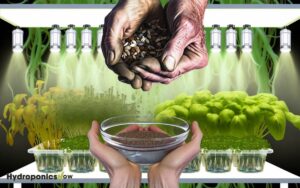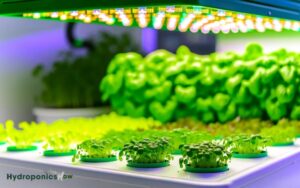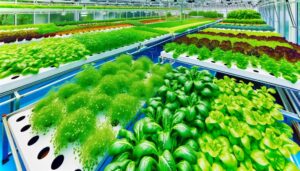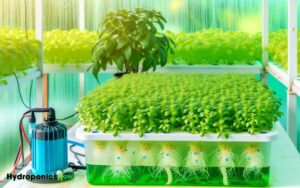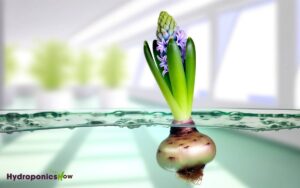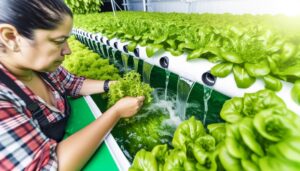3 Steps to Grow Hydroponic Weed Plants – A Complete Guide
Growing hydroponic weed plants involves mastering several key elements. Start with a reliable hydroponic system like Deep Water Culture (DWC) or Nutrient Film Technique (NFT) and select high-quality grow lights—preferably LEDs or HIDs.
Carefully manage nutrients, guaranteeing balanced macronutrients (N, P, K) and micronutrients (Fe, Zn). Control pH levels (5.5-6.5) and electrical conductivity (800-1500 ppm).
Maintain ideal environmental conditions: temperatures between 70-85°F, and humidity levels tailored to each growth stage. Regularly monitor water quality and utilize clean, filtered water.
This all-encompassing approach guarantees robust plant health and high yields. Implementing these practices can greatly improve your results.

Key Takeaways
- Select appropriate hydroponic systems like Deep Water Culture (DWC) and ensure precise control of pH (5.5-6.5) and electrical conductivity.
- Utilize balanced nutrient solutions with essential macronutrients (N, P, K) and micronutrients, adjusting ratios based on growth stages.
- Employ optimal grow lights, such as full-spectrum LEDs, and maintain proper light intensity and positioning.
- Monitor environmental conditions, maintaining ideal temperature (70-85°F) and humidity levels, and using equipment like fans and dehumidifiers.
Understanding Hydroponics
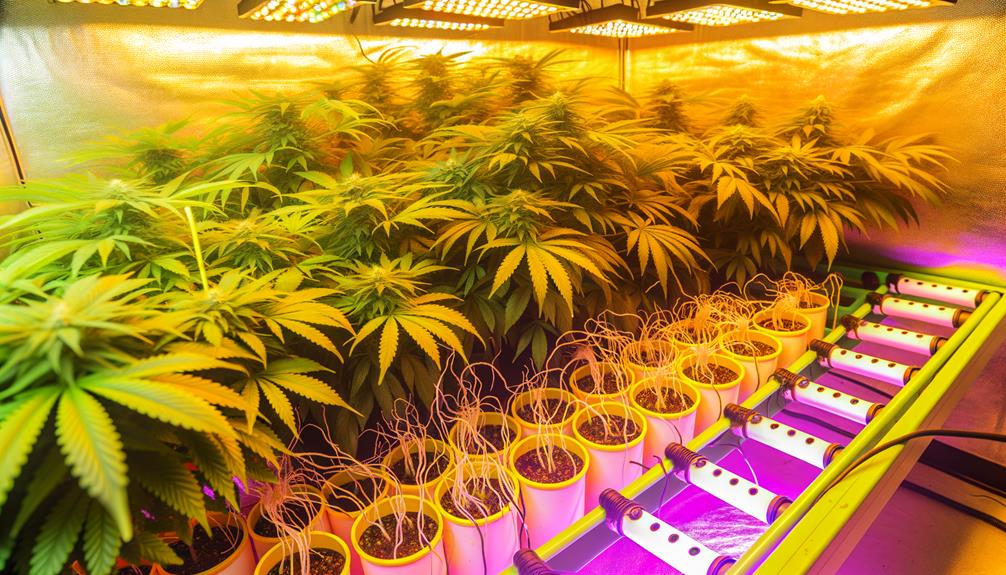
Hydroponics is a method of growing plants without soil by using mineral nutrient solutions in an aqueous solvent. This technique leverages the principles of plant physiology to deliver nutrients directly to the root system, maximizing growth rates and yields.
The nutrient solution must be carefully balanced, containing essential macronutrients such as nitrogen (N), phosphorus (P), and potassium (K), as well as micronutrients like iron (Fe), manganese (Mn), and zinc (Zn). By maintaining precise control over pH and electrical conductivity (EC), hydroponic systems guarantee ideal nutrient uptake.
Various hydroponic systems include Deep Water Culture (DWC), Nutrient Film Technique (NFT), and Aeroponics, each offering unique advantages. Understanding these principles is crucial for achieving successful cultivation in hydroponic environments.
Essential Equipment
To achieve ideal growth in hydroponic weed cultivation, selecting appropriate grow lights and nutrient solutions is paramount.
High-intensity discharge (HID) and light-emitting diode (LED) lights are the most effective for simulating natural sunlight.
Equally important is the formulation of nutrient solutions, which must be precisely balanced to deliver essential macro and micronutrients required for cannabis growth stages.
Grow Lights Selection
Selecting the appropriate grow lights is vital for enhancing the photosynthesis process and guaranteeing the healthy development of hydroponic weed plants.
The primary options include High-Intensity Discharge (HID), Light Emitting Diodes (LED), and Fluorescent lights.
HID lights, comprising Metal Halide (MH) and High-Pressure Sodium (HPS), provide intense illumination but generate substantial heat.
LEDs offer energy efficiency, lower heat emission, and customizable light spectra, making them ideal for various growth stages.
Fluorescent lights, specifically T5, are suitable for seedlings and clones due to their lower intensity and cooler temperature.
It’s important to take into account the light spectrum, intensity (measured in lumens), and coverage area.
Position lights at a suitable distance to prevent light burn and guarantee uniform light distribution.
Nutrient Solution Choices
Choosing the ideal nutrient solution is essential for ensuring the balanced supply of necessary minerals and promoting vigorous growth in hydroponic weed plants. Essential nutrients include nitrogen (N), phosphorus (P), and potassium (K), among others. The best nutrient solution should be selected based on the growth stage of the plants.
| Growth Stage | N-P-K Ratio | Additional Nutrients |
|---|---|---|
| Seedling | 2-1-2 | Calcium, Magnesium |
| Vegetative | 3-1-2 | Iron, Sulfur |
| Flowering | 1-2-3 | Manganese, Zinc |
| Cloning | 1-1-1 | Boron, Copper |
| Maintenance | 2-2-2 | Micronutrient blend |
Careful monitoring and adjustment of the nutrient solution pH (5.5-6.5) and electrical conductivity (EC) are critical for best uptake.
Choosing the Right Strains
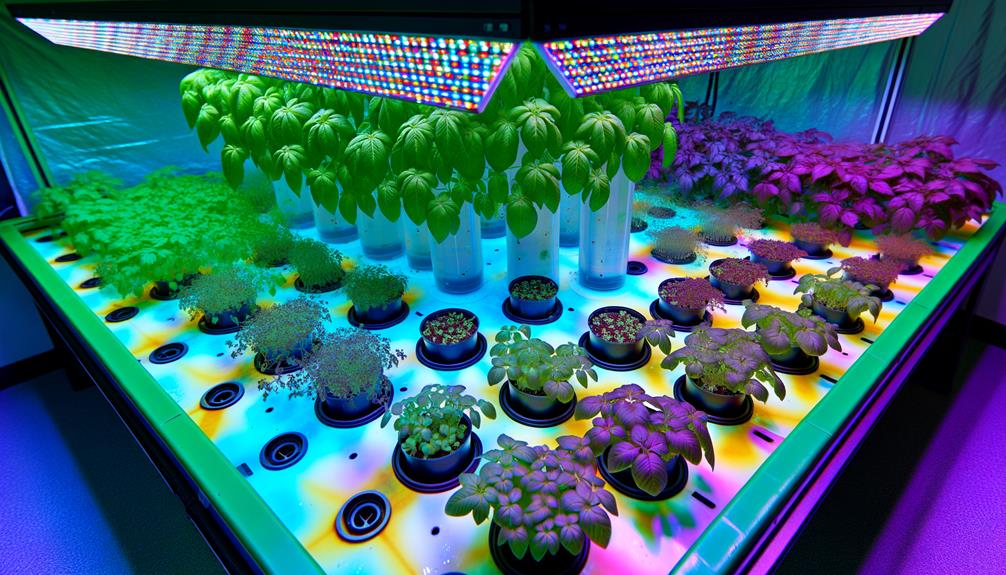
When selecting strains for hydroponic cultivation, one must consider the physiological and morphological differences between Indica and Sativa varieties, which directly impact environmental requirements and growth characteristics.
Evaluating yield expectations is essential, as some strains are genetically predisposed to higher productivity under hydroponic conditions.
Additionally, understanding the growth cycle length of each strain will enable precise planning to optimize harvest timing and resource allocation.
Indica Vs. Sativa
Understanding the fundamental differences between Indica and Sativa strains is essential for optimizing the growth and desired effects of hydroponic weed plants.
Indica strains typically exhibit shorter, bushier growth patterns with broad leaves, making them ideal for limited vertical space in hydroponic setups. Indicas usually have higher CBD content, providing sedative and pain-relieving effects.
Conversely, Sativa strains grow taller with narrow leaves, requiring more vertical space and light. Sativas generally contain higher THC levels, yielding more cerebral, energizing effects.
Selecting the appropriate strain involves evaluating spatial constraints, light availability, and desired cannabinoid profiles.
Employing precise nutrient management, pH control, and environmental monitoring tailored to the chosen strain will maximize plant health and efficacy.
Yield Expectations
Selecting strains with high yield potential is essential for optimizing the productivity of hydroponic weed plants, necessitating a thorough understanding of genetic profiles and growth characteristics. By carefully analyzing factors such as resistance to pests, nutrient uptake efficiency, and flowering time, growers can maximize their harvests. Implementing an easy way to clone weed plants ensures genetic consistency, allowing cultivators to reproduce high-performing strains with minimal variation. This approach not only enhances yield stability but also streamlines the cultivation process for both small-scale and commercial growers.
High-yielding strains, such as Gorilla Glue #4, Big Bud, and White Widow, are renowned for their robust growth and prolific bud production. When evaluating strains, consider factors like flower-to-leaf ratio, bud density, and resistance to pests and diseases.
It is vital to source seeds from reputable breeders who provide detailed genetic information. Additionally, hybrid strains often offer a balanced combination of desirable traits from both indica and sativa parents, enhancing yield potential.
Implementing these considerations will enable cultivators to achieve maximum output and efficiency in their hydroponic systems.
Growth Cycle Length
Evaluating the growth cycle length of various cannabis strains is essential for synchronizing plant development with the operational timelines of hydroponic systems. Different strains exhibit varied periods from germination to harvest, influencing both the yield and resource allocation.
- Indica Strains: Typically, these strains have shorter flowering periods, usually around 8-10 weeks, making them ideal for quick turnover in hydroponic setups.
- Sativa Strains: Known for their longer flowering times, often stretching from 10-16 weeks, sativas require extended management but yield higher THC levels.
- Hybrid Strains: Combining traits from both indica and sativa, hybrids offer a balanced growth cycle, generally ranging from 9-12 weeks, providing versatility in cultivation planning.
Selecting the appropriate strain guarantees optimized growth cycles and efficient resource utilization.
Setting Up Your System
To establish a robust hydroponic system for growing weed plants, it is essential to meticulously configure the nutrient delivery apparatus, lighting, and environmental controls to ascertain ideal plant health and growth.
Begin by selecting an appropriate hydroponic setup such as Deep Water Culture (DWC) or Nutrient Film Technique (NFT). Confirm the reservoir is adequately sized and fitted with an air pump to oxygenate water.
Use full-spectrum LED grow lights, positioning them 12-18 inches above plants, adjusting height as they grow. Implement timers to simulate natural photoperiods.
Employ environmental controls like fans, dehumidifiers, and thermostats to maintain ideal temperature (70-85°F) and humidity (40-60%).
Regularly monitor pH levels, keeping them between 5.5 and 6.5 for nutrient absorption.
Nutrient Solutions
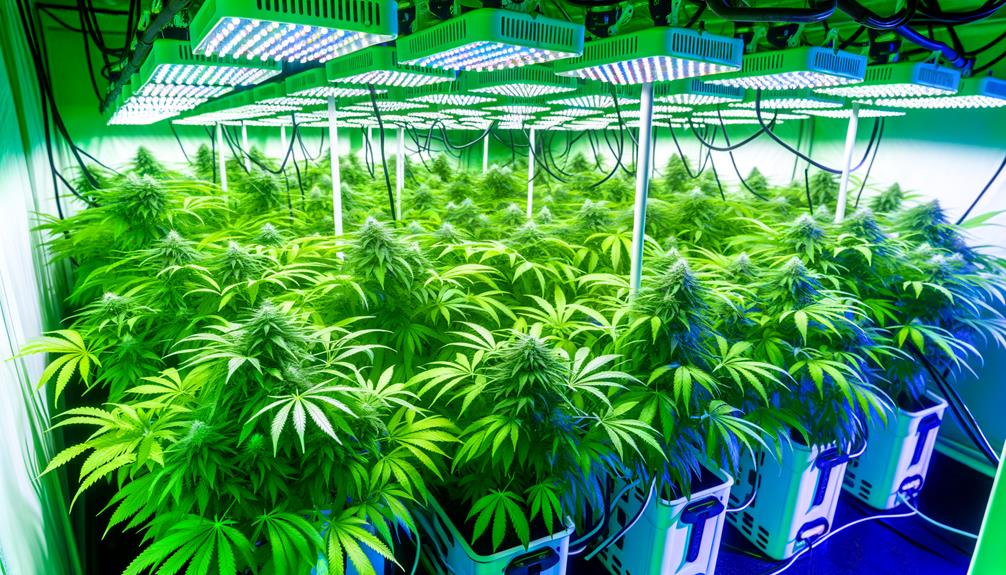
A meticulously balanced nutrient solution is crucial for ideal growth and health of hydroponic weed plants. The nutrient solution must provide all the macro and micronutrients necessary for cannabis plants to thrive.
Here are three critical components to take into account:
- Macronutrients: Confirm the solution contains nitrogen (N), phosphorus (P), and potassium (K) in appropriate ratios, typically around 3-1-2 during the vegetative stage and 1-3-2 during flowering.
- Micronutrients: Include essential elements such as calcium (Ca), magnesium (Mg), and iron (Fe), which are essential for various physiological functions.
- pH Levels: Maintain the pH of the nutrient solution between 5.5 and 6.5 to maximize nutrient uptake and prevent deficiencies.
Regular monitoring and adjustments will guarantee best plant health.
Lighting Requirements
Proper lighting is vital for the successful cultivation of hydroponic cannabis, necessitating an understanding of ideal light spectrum, photoperiod, and intensity.
Cannabis plants require specific wavelengths, particularly blue and red light, to support various growth stages.
Additionally, managing the photoperiod and ensuring appropriate light intensity are essential to maximize photosynthetic efficiency and yield.
Optimal Light Spectrum
Selecting the appropriate light spectrum is fundamental for the ideal growth and development of hydroponic weed plants. Specific wavelengths stimulate various physiological processes. Refining the light spectrum involves understanding:
- Blue Light (400-500 nm): Essential during the vegetative stage, blue light promotes robust leaf development and dense plant structure by stimulating chlorophyll production.
- Red Light (600-700 nm): Critical during the flowering stage, red light encourages bud formation and enhances yield by influencing phytochrome-mediated flowering processes.
- Full Spectrum LED Lights: These lights combine multiple wavelengths, emulating natural sunlight, and guarantee balanced growth throughout all plant stages.
Attention to these light spectra guarantees that hydroponic weed plants receive the best wavelengths for each stage, fostering healthy, vigorous growth.
Photoperiod and Intensity
Establishing an ideal photoperiod and light intensity is essential for maximizing the growth and yield of hydroponic weed plants.
During the vegetative stage, cannabis plants require 18-24 hours of light per day, promoting robust growth and branching.
Shifting to the flowering stage, a 12-hour light and 12-hour dark cycle is critical to induce bud formation.
Light intensity, measured in PPFD (Photosynthetic Photon Flux Density), should range from 400-600 µmol/m²/s during vegetative growth and increase to 600-900 µmol/m²/s in the flowering phase.
Utilizing high-quality LED or HID lights guarantees peak photon delivery.
Proper distance between lights and canopy, generally 12-18 inches for LEDs, prevents light burn and guarantees even coverage.
Temperature and Humidity
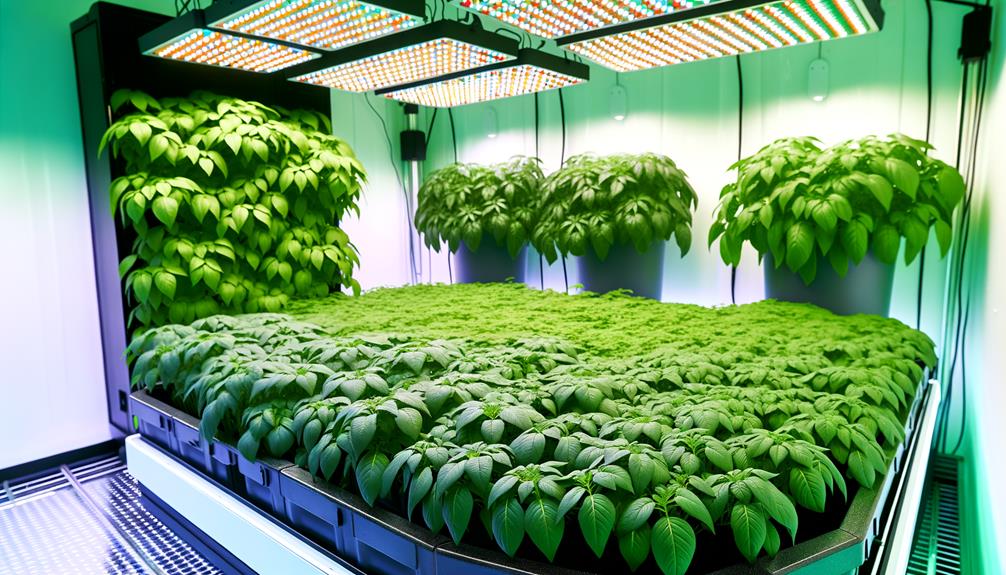
Maintaining ideal temperature and humidity levels is essential for the successful cultivation of hydroponic cannabis plants, as these environmental factors directly impact plant metabolism and growth.
Best temperature ranges from 70°F to 85°F (21°C to 29°C) during the light period and slightly cooler during the dark period. Humidity should be carefully monitored, with seedlings requiring 65-70% relative humidity, vegetative stages at 40-70%, and flowering stages at 40-50%.
Key points to manage:
- Temperature Control: Use air conditioning, heaters, and fans to maintain stable temperatures.
- Humidity Regulation: Employ dehumidifiers and humidifiers to adjust humidity levels as needed.
- Monitoring Equipment: Utilize digital hygrometers and thermostats to continuously track environmental conditions.
Precise control guarantees healthy, vigorous growth and maximizes yield.
Water Management
Proper water management is fundamental to hydroponic cannabis cultivation, ensuring plants receive an ideal balance of nutrients and oxygen. Maintaining favorable water quality involves monitoring pH levels, total dissolved solids (TDS), and temperature. Ideal pH ranges between 5.5 and 6.5, while TDS should be 800-1500 ppm for cannabis. Water temperature should be maintained between 65-70°F to prevent root diseases and promote nutrient uptake. Regularly changing the nutrient solution and using clean, filtered water is essential to avoid pathogen buildup. The table below details important parameters:
| Parameter | Ideal Range | Measurement Tool |
|---|---|---|
| pH Level | 5.5 – 6.5 | pH Meter |
| TDS | 800 – 1500 ppm | TDS Meter |
| Water Temp | 65 – 70°F | Thermometer |
| Nutrient Change | Every 1-2 weeks | Calendar/Reminder System |
| Water Source | Clean, Filtered | Water Filtration System |
Planting and Germination
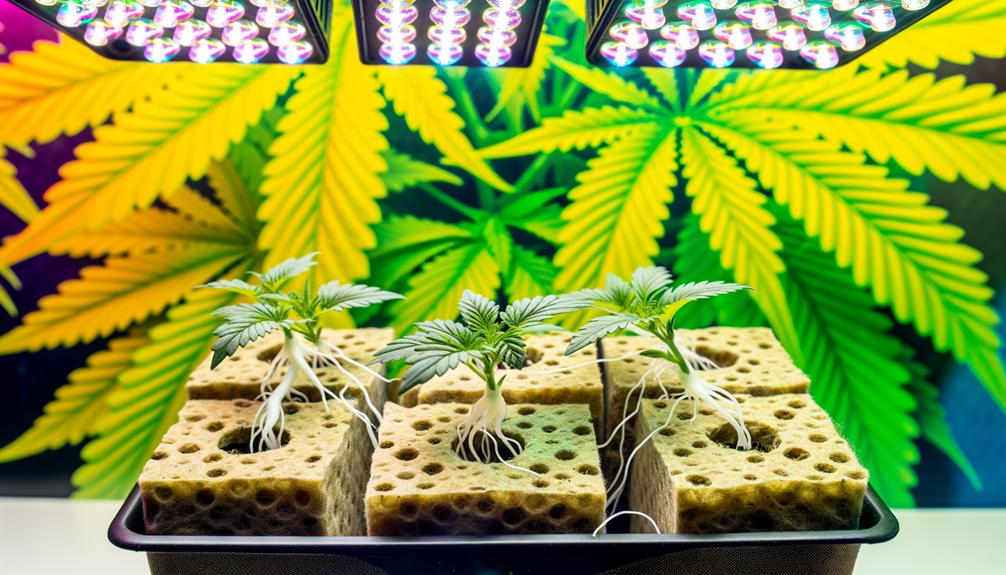
Initiating the planting and germination process in hydroponic cannabis cultivation requires precise control over environmental factors to guarantee ideal seedling development.
Begin by selecting high-quality seeds and ensuring they are stored in a cool, dark place. Use a germination medium, such as rockwool cubes or peat pellets, to provide a sterile and nutrient-rich environment. Maintain optimal conditions by monitoring temperature, humidity, and light exposure.
Key steps include:
- Seed Preparation: Soak seeds in distilled water for 12-24 hours to promote initial hydration and encourage sprouting.
- Placement: Insert seeds into the germination medium, ensuring they remain moist but not waterlogged.
- Environment: Keep the germination area at a consistent temperature of 70-75°F (21-24°C) with 70-90% humidity for peak growth.
Monitoring Growth
Continuous monitoring of hydroponic cannabis growth involves meticulously tracking key parameters such as nutrient concentration, pH levels, and environmental conditions to guarantee optimal plant health and development.
Accurate measurement of Electrical Conductivity (EC) facilitates ideal nutrient solution strength, preventing deficiencies or toxicities. Maintain pH levels between 5.5 and 6.5 using a calibrated pH meter, as deviations can hinder nutrient uptake.
Environmental factors, including temperature and humidity, should be regulated consistently; ideal ranges are 70-85°F and 40-60% relative humidity. Employ sensors and automated systems for real-time data collection and adjustments.
Regularly inspect root health, foliage color, and growth rates to identify and rectify issues promptly. Diligent observation and precise control are essential for thriving hydroponic cannabis cultivation.
Common Issues and Solutions
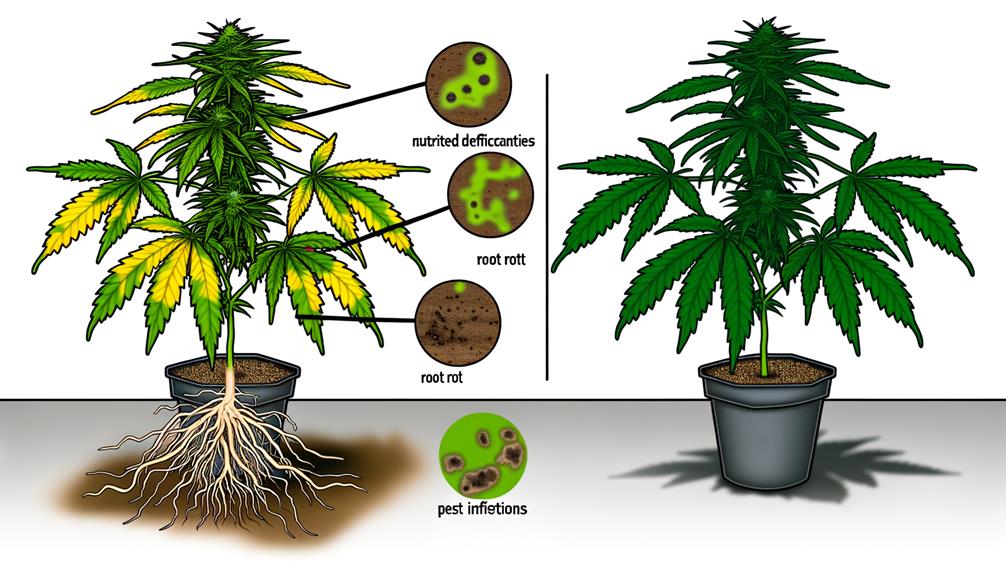
Despite meticulous monitoring, hydroponic cannabis growers frequently encounter common issues such as nutrient imbalances, root rot, and pest infestations, all of which require prompt and effective solutions to guarantee peak plant health. Addressing these issues guarantees ideal growth and yield.
- Nutrient Imbalances: Regularly test the nutrient solution’s pH and electrical conductivity (EC) to maintain ideal levels. Adjust nutrient concentrations according to specific growth stages.
- Root Rot: Ensure adequate oxygenation of the root zone by using air stones or diffusers. Maintain water temperature between 18-22°C to prevent fungal growth.
- Pest Infestations: Implement integrated pest management (IPM) strategies. Use beneficial insects, neem oil, or insecticidal soaps, and maintain cleanliness to prevent infestations.
Conclusion
The cultivation of hydroponic cannabis requires a harmonious balance between technology and nature.
Precise equipment selection juxtaposes the artistry of strain choice, while the complex chemistry of nutrient solutions contrasts with the simplicity of water management.
Rigorous monitoring and timely interventions guarantee healthy growth, mitigating common issues effectively.
This method not only optimizes yield but also exemplifies sustainable horticulture, merging scientific precision with agricultural innovation for enhanced plant development.

